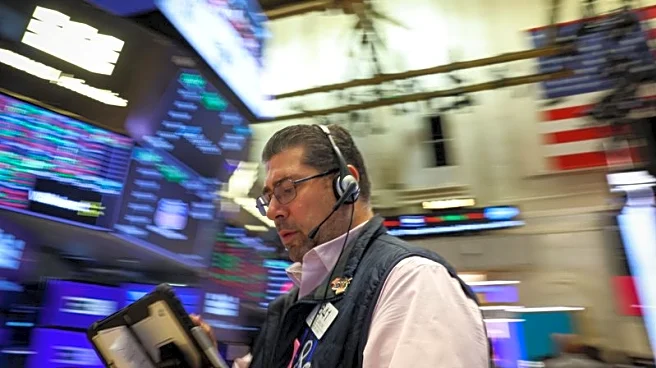What's Happening?
Global stocks remained firm on Monday as traders anticipated U.S. Federal Reserve rate cuts and Japanese stimulus spending. This optimism helped balance concerns about U.S. regional banks and expectations for a strong earnings season for AI-focused companies.
The S&P 500 and Nasdaq 100 were expected to open higher, despite high market volatility. The VIX index, a measure of expected market volatility, remained elevated. Investors are closely watching AI giants like Nvidia and Microsoft for any signs of reduced capital expenditure, which could impact the broader market. Meanwhile, U.S. households' stock market exposure has reached a 75-year high, driven by tech earnings optimism.
Why It's Important?
The anticipation of Federal Reserve rate cuts reflects broader economic concerns, including persistent inflation and credit market uncertainties. The potential rate cuts could provide relief to markets by lowering borrowing costs, which is crucial for sustaining economic growth. However, the high exposure of U.S. households to the stock market, particularly in tech stocks, suggests vulnerability to market fluctuations. The performance of AI companies is critical, as any slowdown could have widespread implications for investor sentiment and market stability. The situation underscores the delicate balance between economic policy, market expectations, and corporate performance.
What's Next?
Investors will be closely monitoring upcoming earnings reports from major companies like Tesla and Netflix, as well as consumer giants like Procter & Gamble and Coca-Cola, for insights into the U.S. economy's health. The Federal Reserve's next policy meeting will be pivotal, especially given the lack of recent employment data due to a government shutdown. Core inflation data expected later this week will also be crucial in shaping market expectations for future rate cuts. The ongoing geopolitical and economic uncertainties will continue to influence market dynamics, with potential implications for global financial stability.
Beyond the Headlines
The current market environment highlights the interconnectedness of global economies and the impact of monetary policy on financial markets. The potential for rate cuts in the U.S. and stimulus measures in Japan reflects broader efforts to support economic growth amid global uncertainties. However, the reliance on AI and tech stocks raises questions about market concentration and the sustainability of current valuations. As central banks navigate these challenges, the balance between supporting growth and managing inflation will be critical for long-term economic stability.














